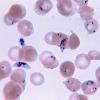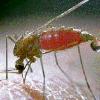

- » Malaria causing mosquitoes evolving into new species
- » Malaria mortality rate underestimated in India
- » Rich countries urged to step up AIDS fight funding to sustain progress
- » Panama first lady raising money to deliver medical supplies to homeland's indigenous people
- » Spokesman says British pop singer Cheryl Cole is treated for malaria in London hospital
- » HIV/AIDS patients being turned away in Africa because of donor cuts, aid group says
- » Health aid group says donors are retreating on AIDS support, consequences felt across Africa
- » UNAIDS chief warns donor funding cuts could lead to HIV "nightmare" in Africa
- » UN says mother-to-child HIV transmission can be eliminated by 2015
- » DNA studies show a frail King Tut succumbed to malaria and a broken leg
A thin-film Giemsa stained micrograph of ring-forms, and gametocytes of Plasmodium falciparum. Tags: Malaria View |
Malaria is caused by a parasite transmitted from one human to another via the bite of an infected Anopheles mosquito The parasites migrate to the liver mature and enter the bloodstream Topics: Health Tags: Malaria View |
Mosquitoes pass the parasites to people when they drink blood through the skin However only the female Anopheles mosquitoes drink blood The males feed only on plant juices VOICE ONE The female Anopheles mosquito drinks blood from people and animals by breaking through the skin with its long tube like feeding device The parasites enter the blood of the victim The Topics: Health Tags: Malaria View |
|||||||||
Malaria is a mosquito-borne infectious disease caused by a eukaryotic protist of the genus Plasmodium. It is widespread in tropical (Tropics) and subtropical regions, including parts of the Americas, Asia, and Africa. Each year, there are approximately 350-500 million cases of malaria, killing between one and three million people, the majority of whom are young children in Sub-Saharan Africa. Ninety percent of malaria-related deaths occur in Sub-Saharan Africa. Malaria is commonly associated with poverty, but is also a cause of poverty and a major hindrance to economic development.
Five species of the plasmodium parasite can infect humans; the most serious forms of the disease are caused by Plasmodium falciparum. Malaria caused by Plasmodium vivax, Plasmodium ovale and Plasmodium malariae causes milder disease in humans that is not generally fatal. A fifth species, Plasmodium knowlesi, is a zoonosis that causes malaria in macaques but can also infect humans.
Malaria is naturally transmitted by the bite of a female Anopheles mosquito (Anopheles). When a mosquito bites an infected person, a small amount of blood is taken, which contains malaria parasites. These develop within the mosquito and about one week later, when the mosquito takes its next blood meal, the parasites are injected into the person being bitten with the mosquitos saliva. After a period of between 2 weeks and several months (occasionally years) spent in the liver, the malaria parasites start to multiply within red blood cells, causing symptoms that include fever and headache. In severe cases the disease worsens leading to coma, and death.
A wide variety of antimalarial drugs are available to treat malaria. In the last 5 years treatment of P. falciparum infections in endemic countries has been transformed by the use of combinations of drugs containing an artemisinin derivative. Severe malaria is treated with intravenous or intramuscular quinine or, increasingly, the artemisinin derivative artesunate. Several drugs are also available to prevent malaria in travellers to malaria-endemic (Endemic (epidemiology)) countries (prophylaxis (malaria prophylaxis)). Resistance has developed to several antimalarial drugs, most notably chloroquine.
Malaria transmission can be reduced by preventing mosquito bites with mosquito nets and insect repellents, or by mosquito control measures such as spraying insecticides inside houses and draining standing water where mosquitoes lay their eggs.
Although many are under development, the challenge of producing a widely available vaccine that provides a high level of protection for a sustained period is still to met
Icd10: ICD10B50b50
Icd9: ICD9084
Diseasesdb: 7728
Medlineplus: 000621
Omim: 248310
Emedicinesubj: med
Emedicinetopic: 1385
Emedicine Mult: eMedicine2emerg305 eMedicine2ped1357
Meshname: Malaria
Number on List: C03.752.250.552



